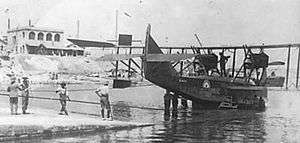Felixstowe F.3
| Felixstowe F.3 | |
|---|---|
 | |
| Felixstowe F.3, Canada 1920 | |
| Role | Military flying boat |
| National origin | United Kingdom |
| Manufacturer | Short Brothers Dick, Kerr & Co. Phoenix Dynamo Manufacturing Company Malta Dockyard (23) Canadian Vickers |
| Designer | John Cyril Porte |
| First flight | February 1917 |
| Introduction | February 1918 |
| Primary users | Royal Naval Air Service Royal Air Force United States Navy |
| Number built | 182 |
| Developed from | Felixstowe F.2 |
| Variants | Felixstowe F.5 Felixstowe F5L |
The Felixstowe F.3 was a British First World War flying boat, successor to the Felixstowe F.2 designed by Lieutenant Commander John Cyril Porte RN at the naval air station, Felixstowe.
Design and development
In February 1917, the first prototype of the Felixstowe F.3 was flown. This was a larger and heavier development of the Felixstowe F.2A, powered by two 320 hp (239 kW) Sunbeam Cossack engines.[1] Large orders followed, with the production aircraft powered by Rolls-Royce Eagles. The F.3's larger size gave it greater range and a heavier bombload than the F2, but poorer speed and agility. Approximately 100 Felixstowe F.3s were produced before the end of the war, including 18 built by the Dockyard Constructional Unit at Malta.[2]
Operational history
The larger F.3, which was less popular with its crews than the more maneuverable F.2A, served in the Mediterranean as well as the North Sea.
In 1920, the Canadian Air Board sponsored a project to conduct the first-ever Trans-Canada flight to determine the feasibility of such flights for future air mail and passenger service. The leg from Rivière du Loup to Winnipeg was flown by Lieutenant Colonel Leckie and Major Hobbs in a Felixstowe F.3.
On the 22 March 1921, a Felixtowe F.3 flying boat of the Portuguese Naval Aviation – crewed by the naval aviators Sacadura Cabral and Ortins de Bettencourt, naval navigator Gago Coutinho and aviation mechanic Roger Soubiran – performed the first flight between Mainland Portugal and Madeira.
Operators
- Aeronáutica Naval España
- Spanish seaplane carrier Dédalo – three carried
Specifications (F.3)
Data from British Naval Aircraft since 1912 [3]
General characteristics
- Crew: four
- Length: 49 ft 2 in (14.99 m)
- Wingspan: 102 ft (31.09 m)
- Height: 18 ft 8 in (5.69 m)
- Wing area: 1,432 ft² (133.03 m²)
- Empty weight: 7,958 lb (3,610 kg)
- Loaded weight: 12,235 lb (5,550 kg)
- Powerplant: two × Rolls-Royce Eagle VIII V12 inline piston, 345 hp (257 kW) each
Performance
- Maximum speed: 91 mph (79 knots, 147 km/h) at 2,000 ft (610 m)
- Service ceiling: 8,000 ft (2,438 m)
- Wing loading: 8.54 lb/ft² (41.8 kg/m²)
- Power/mass: 0.056 hp/lb (0.092 kW/kg)
- Endurance: Six hours
- Climb to 2,000 ft (610 m): 5 min 15 s
- Climb to 6,500 ft (1,980 m): 24 min
Armament
- Guns: 4 × Lewis guns (one in the nose, three amidships)
- Bombs: Up to 920 lb (418 kg) of bombs beneath wings
See also
- Canadian Vickers – Felixstowe F-III built for transatlantic attempt
Related development
References
- ↑ Bruce 16 December 1955, p.897.
- ↑ Ransom and Fairclough, S and R (1987). "English Electric Aircraft and their Predecessors". Their Fighting Machines. Putnam. Retrieved 7 January 2017.
Further reading
- Bruce, J.M. "The Felixstowe Flying-Boats: Historic Military Aircraft No. 11 Part 1". Flight, 2 December 1955, pp. 842–846.
- Bruce, J.M. "The Felixstowe Flying-Boats: Historic Military Aircraft No. 11 Part 2". Flight, 16 December 1955, pp. 895–898.
- Bruce, J.M. "The Felixstowe Flying-Boats: Historic Military Aircraft No. 11 Part 3". Flight, 23 December 1955, pp. 929–932.
- Thetford, Owen. British Naval Aircraft since 1912. London: Putnam, Fourth edition, 1978. ISBN 0-370-30021-1.
External links
| Wikimedia Commons has media related to Felixstowe Flying Boats. |
- The First Trans-Canada Flight: Photographs including the Felixstowe F.3 flown by Leckie and Hobbs during October 1920 and their stop in Selkirk, Manitoba.
- Fire Fighting with Aeroplanes: Film showing the use of flying boats, including a Felixstowe F.3 (G-CYBT) and seaplanes to help prevent forest fires in Algonquin Provincial Park, Ontario, Canada, c.1922.
- In the Wake of Captain Cook: Canadian Government Motion Picture Bureau film of a visit by F.3 flying boat (G-CYDI) to Nootka Sound on Vancouver Island, Canada, c.1922.
- Felixstowe Flying-Boats
